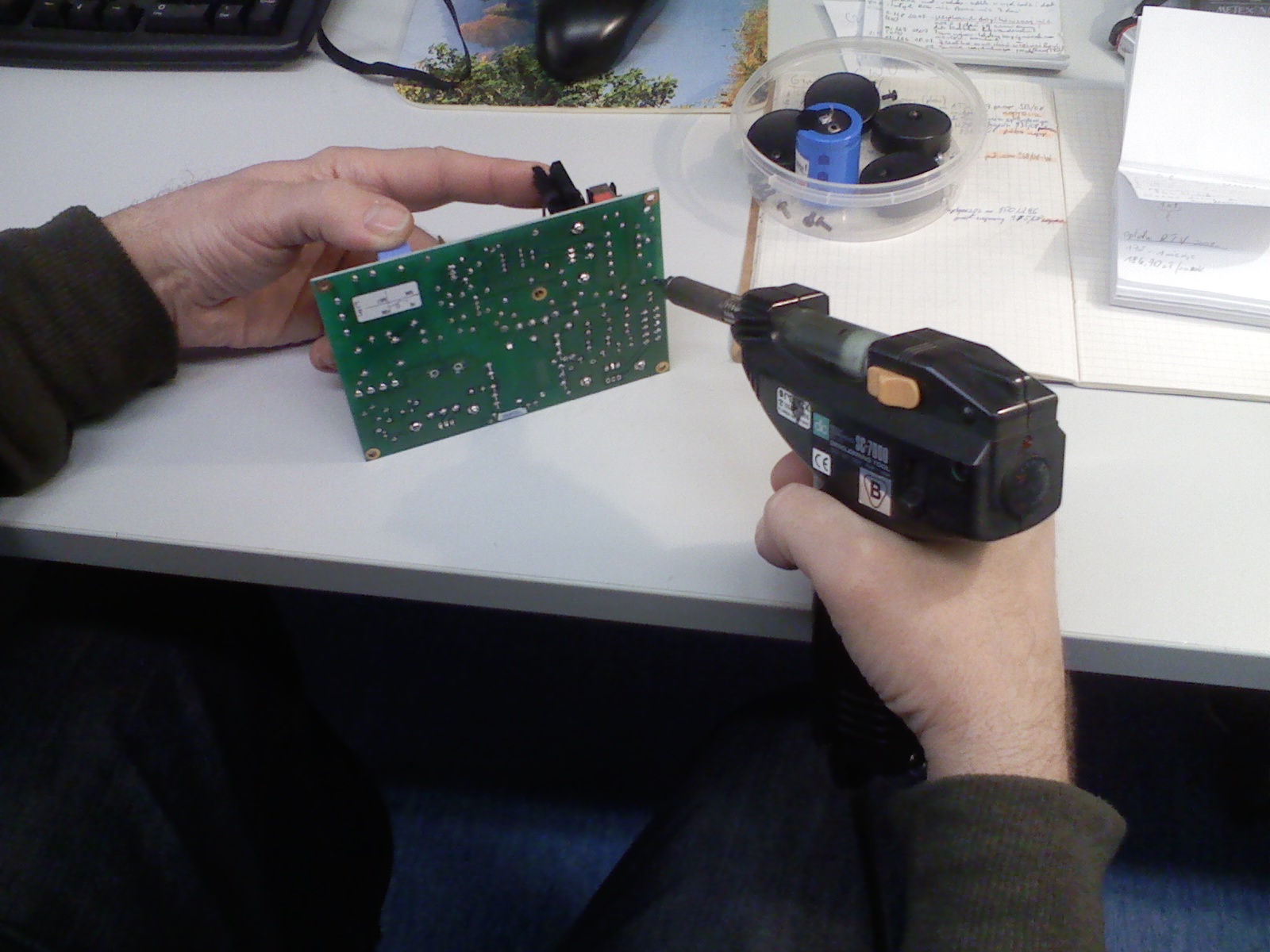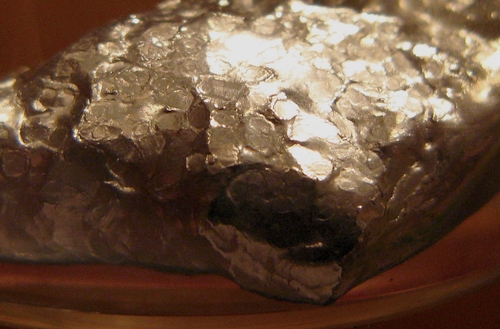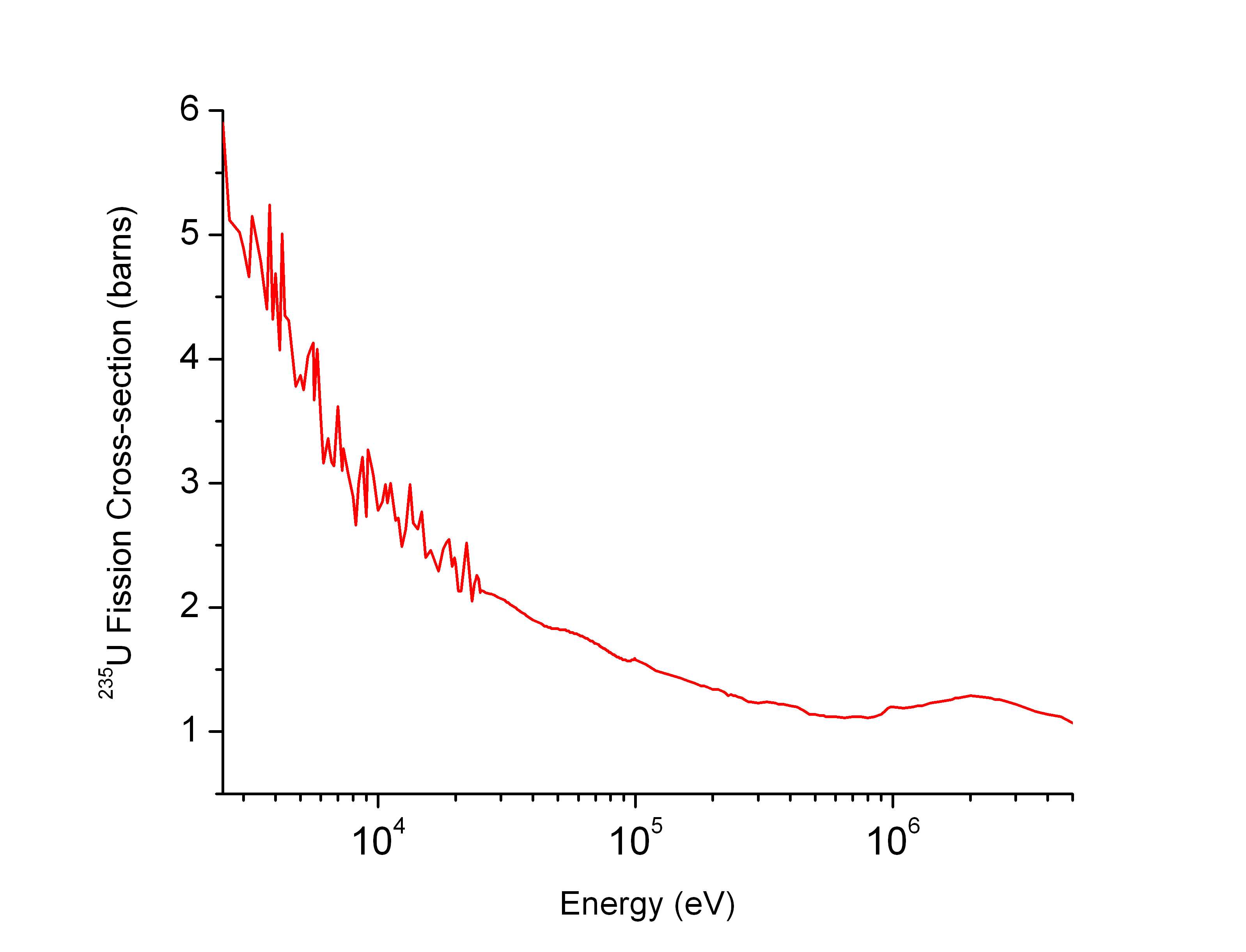|
Fusible Alloy
A fusible alloy is a metal alloy capable of being easily fused, i.e. easily meltable, at relatively low temperatures. Fusible alloys are commonly, but not necessarily, eutectic alloys. Sometimes the term "fusible alloy" is used to describe alloys with a melting point below . Fusible alloys in this sense are used for solder. Introduction Fusible alloys are typically made from low melting metals. There are 14 low melting metallic elements that are stable for practical handling. These are in 2 distinct groups: The 5 alkali metals have 1 s electron and melt between +181 (Li) and +28 (Cs) Celsius; The 9 poor metals have 10 d electrons and from none (Zn, Cd, Hg) to three (Bi) p electrons, they melt between -38 (Hg) and +419 (Zn) Celsius. From a practical view, low-melting alloys can be divided into the following categories: * Mercury-containing alloys *Only alkali metal-containing alloys *Gallium-containing alloys (but neither alkali metal nor mercury) *Only bismuth, lead, tin, cad ... [...More Info...] [...Related Items...] OR: [Wikipedia] [Google] [Baidu] |
Metal
A metal () is a material that, when polished or fractured, shows a lustrous appearance, and conducts electrical resistivity and conductivity, electricity and thermal conductivity, heat relatively well. These properties are all associated with having electrons available at the Fermi level, as against nonmetallic materials which do not. Metals are typically ductile (can be drawn into a wire) and malleable (can be shaped via hammering or pressing). A metal may be a chemical element such as iron; an alloy such as stainless steel; or a molecular compound such as polythiazyl, polymeric sulfur nitride. The general science of metals is called metallurgy, a subtopic of materials science; aspects of the electronic and thermal properties are also within the scope of condensed matter physics and solid-state chemistry, it is a multidisciplinary topic. In colloquial use materials such as steel alloys are referred to as metals, while others such as polymers, wood or ceramics are nonmetallic ... [...More Info...] [...Related Items...] OR: [Wikipedia] [Google] [Baidu] |
Cerrolow 136
Cerrolow 136, is a fusible alloy that becomes liquid at approximately 58 °C (136 °F). It is a eutectic alloy of bismuth, lead, indium, and tin, with the following percentages by weight: 49% Bi, 18% Pb, 21% In, 12% Sn. It is also known as ChipQuik desoldering alloy.Johnson Manufacturing CoMSDS for Chip Quik Alloy w/Lead Retrieved on February 6, 2015. and Lens Alloy 136, used for mounting lenses and other optical components for grinding. Used for mounting small delicate oddly-shaped components for machining. It slightly expands on cooling, later shows slight shrinkage in couple hours afterwards. Used as a solder in low-temperature physics. The Young's Modulus is approximately 2.5 million psi (17.24 GPa) Retrieved 5 December 2019. Similar metals References {{reflist Fusible alloys ... [...More Info...] [...Related Items...] OR: [Wikipedia] [Google] [Baidu] |
Desoldering
In electronics, desoldering is the removal of solder and components from a Printed circuit board, circuit board for troubleshooting, repair, replacement, and salvage. Tools Desoldering tools and materials include the following: *Solder wick *Heat guns, also called hot air guns *Desoldering pump *Removal alloys *Removal fluxes *Heated soldering tweezers *Various picks and tweezers for tasks such as pulling at, holding, removing, and scraping components. *Vacuum and pressure pumps with specialized heater tips and nozzles *Rework stations, used to repair printed circuit board assemblies that fail factory test. Terminology is not totally standardised. Anything with a base unit with provision to maintain a stable temperature, pump air in either direction, etc., is often called a "station" (preceded by rework, soldering, desoldering, hot air); one, or sometimes more, tools may be connected to a station, e.g., a rework station may accommodate a soldering iron and hot air head. A solde ... [...More Info...] [...Related Items...] OR: [Wikipedia] [Google] [Baidu] |
Cerrolow 117
Wood's metal, also known as Lipowitz's alloy or by the commercial names Cerrobend, Bendalloy, Pewtalloy and MCP 158, is a fusible metal alloy (having a low melting point) that is useful for soldering and making custom metal parts. The alloy is named for Barnabas Wood, who invented and patented the alloy in 1860. It is a eutectic alloy of 50% bismuth, 26.7% lead, 13.3% tin, and 10% cadmium by mass. It has a melting point of approximately . Its fumes are toxic, as well as being toxic on skin exposure. Applications Wood's metal is used for making fusible links in the sprinkler heads of commercial building automatic fire sprinkler systems. Due to the fire, ambient temperature increases enough to melt the link, releasing the water. A similar use is fusible plugs in boilers. Uses also include making custom-shaped apertures and blocks (for example, electron-beam cutouts and lung blocks) for medical radiation treatment, and making casts of keys that are hard ... [...More Info...] [...Related Items...] OR: [Wikipedia] [Google] [Baidu] |
Rubidium
Rubidium is a chemical element; it has Symbol (chemistry), symbol Rb and atomic number 37. It is a very soft, whitish-grey solid in the alkali metal group, similar to potassium and caesium. Rubidium is the first alkali metal in the group to have a density higher than Properties of water, water. On Earth, natural rubidium comprises two isotopes: 72% is a stable isotope Rb, and 28% is slightly radioactive Rb, with a half-life of 48.8 billion years – more than three times as long as the estimated age of the universe. German chemists Robert Bunsen and Gustav Kirchhoff discovered rubidium in 1861 by the newly developed technique, Atomic emission spectroscopy#Flame emission spectroscopy, flame spectroscopy. The name comes from the Latin word , meaning deep red, the color of its emission spectrum. Rubidium's compounds have various chemical and electronic applications. Rubidium metal is easily vaporized and has a convenient spectral absorption range, making it a frequent target for ... [...More Info...] [...Related Items...] OR: [Wikipedia] [Google] [Baidu] |
Caesium
Caesium (IUPAC spelling; also spelled cesium in American English) is a chemical element; it has Symbol (chemistry), symbol Cs and atomic number 55. It is a soft, silvery-golden alkali metal with a melting point of , which makes it one of only five elemental metals that are liquid at or near room temperature. Caesium has physical and chemical properties similar to those of rubidium and potassium. It is pyrophoricity, pyrophoric and reacts with water even at . It is the least electronegativity, electronegative stable element, with a value of 0.79 on the Pauling scale. It has only one stable isotope, caesium-133. Caesium is mined mostly from pollucite. Caesium-137, a fission product, is extracted from waste produced by nuclear reactor technology, nuclear reactors. It has the largest atomic radius of all elements whose radii have been measured or calculated, at about 260 picometres. The German chemist Robert Bunsen and physicist Gustav Kirchhoff discovered caesium in 1860 by the new ... [...More Info...] [...Related Items...] OR: [Wikipedia] [Google] [Baidu] |
Fire Sprinkler
A fire sprinkler or sprinkler head is the component of a fire sprinkler system that discharges water when the effects of a fire have been detected, such as when a predetermined temperature has been exceeded. Fire sprinklers are extensively used worldwide, with over 40 million sprinkler heads fitted each year. In buildings protected by properly designed and maintained fire sprinklers, over 99% of fires were controlled by fire sprinklers alone. History In 1812, British inventor Sir William Congreve, 2nd Baronet, Sir William Congreve patented a manual sprinkler system using perforated pipes along the ceiling. When someone noticed a fire, a valve outside the building could be opened to send water through the pipes. It was not until a short time later that, as a result of a large furniture factory that repeatedly burned down, Hiram Stevens Maxim was consulted on how to prevent a recurrence and invented the first automatic fire sprinkler. It would douse the areas that were on fire an ... [...More Info...] [...Related Items...] OR: [Wikipedia] [Google] [Baidu] |
Steam Boiler
file:Dampfkessel für eine Stationärdampfmaschine im Textilmuseum Bocholt.jpg, An industrial boiler, originally used for supplying steam to a stationary steam engine A boiler or steam generator is a device used to create steam by applying heat energy to water. Although the definitions are somewhat flexible, it can be said that older steam generators were commonly termed ''boilers'' and worked at low to medium pressure () but, at pressures above this, it is more usual to speak of a ''steam generator''. A boiler or steam generator is used wherever a source of steam is required. The form and size depends on the application: mobile steam engines such as steam locomotives, portable engines and Traction engine, steam-powered road vehicles typically use a smaller boiler that forms an integral part of the vehicle; stationary steam engines, industrial installations and power stations will usually have a larger separate steam generating facility connected to the point-of-use by piping. ... [...More Info...] [...Related Items...] OR: [Wikipedia] [Google] [Baidu] |
Nuclear Reactor
A nuclear reactor is a device used to initiate and control a Nuclear fission, fission nuclear chain reaction. They are used for Nuclear power, commercial electricity, nuclear marine propulsion, marine propulsion, Weapons-grade plutonium, weapons production and Research reactor, research. Fissile material, Fissile nuclei (primarily uranium-235 or plutonium-239) absorb single neutron, neutrons and split, releasing energy and multiple neutrons, which can induce further fission. Reactors stabilize this, regulating Neutron absorber, neutron absorbers and neutron moderator, moderators in the core. Fuel efficiency is exceptionally high; Enriched uranium#Low-enriched uranium (LEU), low-enriched uranium is 120,000 times more energy dense than coal. Heat from nuclear fission is passed to a working fluid Nuclear reactor#By coolant, coolant. In commercial reactors, this drives Turbine, turbines and electrical generator shafts. Some reactors are used for district heating, and isotopes, isoto ... [...More Info...] [...Related Items...] OR: [Wikipedia] [Google] [Baidu] |
Neutron Cross-section
In nuclear physics, the concept of a neutron cross section is used to express the likelihood of interaction between an incident neutron and a target nucleus. The neutron cross section σ can be defined as the area in cm2 for which the number of neutron-nuclei reactions taking place is equal to the product of the number of incident neutrons that would pass through the area and the number of target nuclei. In conjunction with the neutron flux, it enables the calculation of the reaction rate, for example to derive the thermal power of a nuclear power plant. The standard unit for measuring the cross section is the barn, which is equal to 10−28 m2 or 10−24 cm2. The larger the neutron cross section, the more likely a neutron will react with the nucleus. An isotope (or nuclide) can be classified according to its neutron cross section and how it reacts to an incident neutron. Nuclides that tend to absorb a neutron and either decay or keep the neutron in its nucleus are neutron a ... [...More Info...] [...Related Items...] OR: [Wikipedia] [Google] [Baidu] |
Sodium
Sodium is a chemical element; it has Symbol (chemistry), symbol Na (from Neo-Latin ) and atomic number 11. It is a soft, silvery-white, highly reactive metal. Sodium is an alkali metal, being in group 1 element, group 1 of the periodic table. Its only stable isotope is 23Na. The free metal does not occur in nature and must be prepared from compounds. Sodium is the Abundance of elements in Earth's crust, sixth most abundant element in the Earth's crust and exists in numerous minerals such as feldspars, sodalite, and halite (NaCl). Many salts of sodium are highly water-soluble: sodium ions have been Leaching (chemistry), leached by the action of water from the Earth, Earth's minerals over eons, and thus sodium and chlorine are the most common dissolved elements by weight in the oceans. Sodium was first isolated by Humphry Davy in 1807 by the electrolysis of sodium hydroxide. Among many other useful sodium compounds, sodium hydroxide (lye) is used in Soap, soap manufac ... [...More Info...] [...Related Items...] OR: [Wikipedia] [Google] [Baidu] |






